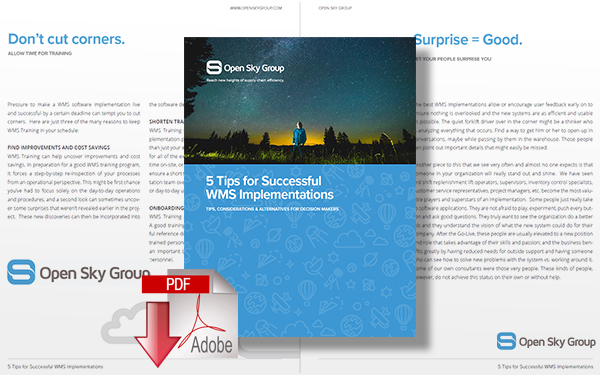How to Make Room in your Budget for a Warehouse Management System Implementation

Transitioning from legacy systems presents hurdles that add to the true cost, however, there are ways to approach your 2020 Warehouse Management System budgeting and the benefits far outweigh the costs.
2020 WMS Budget – Room for an Implementation?
When businesses begin researching Warehouse Management System (WMS) software, they find it can be difficult to budget because pricing is not always readily available.
Transitioning from legacy systems presents hurdles that add to the true cost.
There are ways to approach your 2020 WMS budgeting and the benefits far outweigh the costs.
Tips on Budgeting for a WMS Implementation
Technology will be key to remaining competitive in 2020 and beyond.
The right WMS can help businesses manage supply chains.
Here are some tips for making your 2020 WMS Budget work – and for making room for the implementation:
- List hardware costs – Examine what voice-picking devices, industrial handhelds, and mobile units you have and what your organization will need.
- Calculate software costs – Consider the price of the software, monthly subscription fees, any software support charges, and data migration fees.
- Plan for training – Implementation will save you money and give you a competitive edge, but only if your employees know how to use the new system. Invest in training to ensure a seamless transition.
- Analyze potential gains – WMS spending makes sense when you consider implementation can save your organization between 15 and 25 percent in inventory, provide almost 100 percent inventory accuracy, and reduce labor costs between 20 and 30 percent. Improved customer service also creates both short- and long-term gains.
Additional Resources
Warehouse Management System Total Cost of Ownership (Part 1)
Warehouse Management System Total Cost of Ownership (Part 2)
Warehouse Management System Total Cost of Ownership (Part 3)
Most WMS systems are either under perpetual licensing or operate on a subscription model that typically has a monthly fee. Implementation and annual budgets depend on your business’ choice of deployment.
Perpetual licenses are typically on-premise applications, while subscription models use cloud storage for some of your business’ data and processing needs. With both models, the first-year costs the most due to startup, training, and implementation expenses.
As Blue Yonder experts (formerly JDA RedPrairie Software), we realize there are no one-size-fits-all solutions. That’s why we offer a variety of pricing models and integration services to meet the needs of your business. We can help you make your 2020 WMS Budget a smoother, well-informed process.
2020 WMS Budget – Presenting the case for your WMS Implementation
Once you’ve calculated the costs and have a rough idea of the total, you’ve got to make the case internally. Organizations differ of course, and only you know who you need to work with to ensure your 2020 WMS Budget doesn’t get left out of the process. Here are some tips for supporting your request to your supervisor:
- Focus on Strategic Initiatives - The WMS implementation process begins and ends with C-Suite executives. Each company is different, and therefore the executive team will need to understand the pros and cons of a specific WMS decision before approving the next steps. When preparing the initial high-level presentation, keep the company strategies and goals at the forefront of your approach. For example, if reducing overhead is a top-of-mind organizational concern, present how a WMS project can increase cost-effectiveness. If better customer relations are a primary focus of the company, highlight how WMS implementation can spur faster turnarounds and more efficient chains of communication. Speak to the top level first, and align the specifics around these core strategies.
- Analyze the Impact on Finance, IT, and Operations; Involve Key Personnel - In seeking WMS approval, alignment with several areas of the company is an important part of the process. Operations, Finance, and IT generally represent key departments and decision-makers whose opinions and understanding of workflows and processes are crucial to successful implementation. After determining key personnel, research and investigate how the WMS implementation will positively impact each area of the business within each departmental context. For instance, system integration, ongoing maintenance concerns, and product architecture will be the focus of the IT department. Operations will primarily be concerned with workflow efficiency, problem-solving initiatives, and responding to demands from consumers. Number projections and system payback evaluations will be major areas for the finance department. Bounce your ideas and information off key personnel and adjust the proposed implementation process as necessary.
- Align Strategy with Departmental Research and Findings - After analyzing how the system will mesh with strategic goals, build consensus through streamlining your research. Examine the process and determine when to bring identified personnel into the planning and implementation stages. Establish ongoing reporting metrics to keep key figures abreast of findings, goals, and project activities. Streamline the reports to address your company’s strategic goals in a holistic sense. In an overview, for example, discuss how the WMS reduces overhead on material, staff and IT costs and don’t get bogged down by the specifics that each department head is already familiar with. This will allow you to present a clear vision of the implementation and its alignment with core strategy to the executive team, while also addressing the details that affect the moving parts and decision-makers within the company.
Ultimately, you’ll want to display how WMS will positively affect the bottom-line while boosting competitive positioning and allowing for agility and ongoing strategic alignment. With these steps completed, you’ll have a strong case to present for your WMS project.
Contact Open Sky Group today for a budget-friendly way to implement a Warehouse Management System.
Related White Paper
5 Tips for Successful Warehouse Management System Implementations
This whitepaper, based on years of successful WMS implementations, offers tips for approaching, navigating and successfully completing your Warehouse Management Systems project. Download Now!
More Resources from Open Sky Group
Article Topics
Open Sky Group News & Resources
2024 Productivity Achievement Awards Labor Management: Technology + Methods = Progress Open Sky Group launches advisory services in response to global supply chain challenges Open Sky Group and Dotcom Distribution wrap up first phase of major transformation project What You Need to Consider for a Software-as-a-Service Warehouse Management System 2021 State of Supply Chain Execution Report How Modern Logistics Companies Turn COVID Chaos into Long-Term Business Efficiency More Open Sky GroupLatest in Warehouse|DC
Spotlight Startup: Cart.com Walmart and Swisslog Expand Partnership with New Texas Facility Taking Stock of Today’s Robotics Market and What the Future Holds U.S. Manufacturing Gains Momentum After Another Strong Month Biden Gives Samsung $6.4 Billion For Texas Semiconductor Plants Walmart Unleashes Autonomous Lift Trucks at Four High-Tech DCs Plastic Pollution is a Problem Many Companies are Still Ignoring More Warehouse|DC














